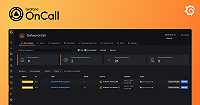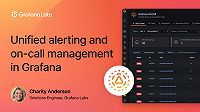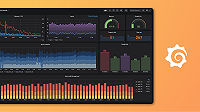Grafana OnCall open source guide
Grafana OnCall is a developer-friendly incident response tool that’s available to Grafana open source and Grafana Cloud users. The OSS version of Grafana OnCall provides the same reliable on-call management solution along with the flexibility of a self-managed environment.
This guide describes the necessary installation and configuration steps needed to configure OSS Grafana OnCall.
Install Grafana OnCall OSS
There are three Grafana OnCall OSS environments available:
- Hobby playground environment for local usage: README.md
- Development environment for contributors: development README.md
- Production environment for reliable cloud installation using Helm: Production Environment
Production Environment
We suggest using our official helm chart for the reliable production deployment of Grafana OnCall. It will deploy Grafana OnCall engine and celery workers, along with RabbitMQ cluster, Redis Cluster, and the database.
Note: The Grafana OnCall engine currently supports one instance of the Grafana OnCall plugin at a time.
Check the helm chart for more details.
We’ll always be happy to provide assistance with production deployment in our communities!
Update Grafana OnCall OSS
To update an OSS installation of Grafana OnCall, please see the update docs:
- Hobby playground environment: README.md
- Production Helm environment: Helm update
Slack Setup
The Slack integration for Grafana OnCall leverages Slack API features to provide a customizable and useful integration. Refer to the following steps to configure the Slack integration:
Ensure your Grafana OnCall environment is up and running
Set
FEATURE_SLACK_INTEGRATION_ENABLEDas TrueGrafana OnCall must be accessible through HTTPS. For development purposes, use localtunnel. For production purposes, consider establishing a proper web server with HTTPS termination. For localtunnel, refer to the following configuration:
# Choose the unique prefix instead of pretty-turkey-83
# Localtunnel will generate an url, e.g. https://pretty-turkey-83.loca.lt
# it is referred as <ONCALL_ENGINE_PUBLIC_URL> below
lt --port 8080 -s pretty-turkey-83 --print-requestsIf using localtunnel, open your external URL and click Continue to allow requests to bypass the warning page.
Create a Slack Workspace for development, or use your company workspace.
Go to https://api.slack.com/apps and click Create an App .
Select
From an app manifestoption and select your workspace.Replace the text with the following YAML code block . Be sure to replace
<YOUR_BOT_NAME>and<ONCALL_ENGINE_PUBLIC_URL>fields with the appropriate information.
_metadata:
major_version: 1
minor_version: 1
display_information:
name: <YOUR_BOT_NAME>
features:
app_home:
home_tab_enabled: false
messages_tab_enabled: true
messages_tab_read_only_enabled: false
bot_user:
display_name: <YOUR_BOT_NAME>
always_online: true
shortcuts:
- name: Add to resolution note
type: message
callback_id: add_resolution_note
description: Add this message to resolution note
slash_commands:
- command: /escalate
url: <ONCALL_ENGINE_PUBLIC_URL>/slack/interactive_api_endpoint/
description: Direct page a team or user(s)
should_escape: false
oauth_config:
redirect_urls:
- <ONCALL_ENGINE_PUBLIC_URL>/api/internal/v1/complete/slack-install-free/
- <ONCALL_ENGINE_PUBLIC_URL>/api/internal/v1/complete/slack-login/
scopes:
user:
- channels:read
- chat:write
- identify
- users.profile:read
bot:
- app_mentions:read
- channels:history
- channels:read
- chat:write
- chat:write.customize
- chat:write.public
- commands
- files:write
- groups:history
- groups:read
- im:history
- im:read
- im:write
- mpim:history
- mpim:read
- mpim:write
- reactions:write
- team:read
- usergroups:read
- usergroups:write
- users.profile:read
- users:read
- users:read.email
- users:write
settings:
event_subscriptions:
request_url: <ONCALL_ENGINE_PUBLIC_URL>/slack/event_api_endpoint/
bot_events:
- app_home_opened
- app_mention
- channel_archive
- channel_created
- channel_deleted
- channel_rename
- channel_unarchive
- member_joined_channel
- message.channels
- message.im
- subteam_created
- subteam_members_changed
- subteam_updated
- user_profile_changed
interactivity:
is_enabled: true
request_url: <ONCALL_ENGINE_PUBLIC_URL>/slack/interactive_api_endpoint/
org_deploy_enabled: false
socket_mode_enabled: falseSet environment variables by navigating to your Grafana OnCall, then click Env Variables and set the following:
textSLACK_CLIENT_OAUTH_ID = Basic Information -> App Credentials -> Client ID SLACK_CLIENT_OAUTH_SECRET = Basic Information -> App Credentials -> Client Secret SLACK_SIGNING_SECRET = Basic Information -> App Credentials -> Signing Secret SLACK_INSTALL_RETURN_REDIRECT_HOST = << OnCall external URL >>In OnCall, navigate to ChatOps, select Slack and click Install Slack integration.
Configure additional Slack settings.
Telegram Setup
The Telegram integration for Grafana OnCall is designed for collaborative team work and improved incident response. It’s available in two options: using Webhooks or Long Polling. Refer to the following steps to configure the Telegram integration:
- Ensure your Grafana OnCall environment is up and running.
- Set
FEATURE_TELEGRAM_INTEGRATION_ENABLEDas “True” - (Long Polling only) Set
FEATURE_TELEGRAM_LONG_POLLING_ENABLEDas “True” - Create a Telegram bot using BotFather and save the token provided by BotFather. Please make sure to disable Group Privacy for the bot (Bot Settings -> Group Privacy -> Turn off).
- Paste the token provided by BotFather to the
TELEGRAM_TOKENvariable on the Env Variables page of your Grafana OnCall instance. - (Webhook only) Set the
TELEGRAM_WEBHOOK_HOSTvariable to the external address of your Grafana OnCall instance. Please note thatTELEGRAM_WEBHOOK_HOSTmust start withhttps://and be publicly available (meaning that it can be reached by Telegram servers). If your host is private or local, consider using a reverse proxy (e.g. ngrok). - Now you can connect Telegram accounts on the Users page and receive alert groups to Telegram direct messages. Alternatively, in case you want to connect Telegram channels to your Grafana OnCall environment, navigate to the ChatOps tab.
Grafana OSS-Cloud Setup
The benefits of connecting to Grafana Cloud OnCall include:
- Grafana Cloud OnCall could monitor OSS OnCall uptime using heartbeat
- SMS for user notifications
- Phone calls for user notifications.
To connect to Grafana Cloud OnCall, refer to the Cloud page in your OSS Grafana OnCall instance.
Supported Phone Providers
Twilio
Grafana OnCall supports Twilio SMS and phone call notifications delivery. If you prefer to configure SMS and phone call notifications using Twilio, complete the following steps:
- Set
GRAFANA_CLOUD_NOTIFICATIONS_ENABLEDas False to ensure the Grafana OSS <-> Cloud connector is disabled. - From your OnCall environment, select Env Variables and configure all variables starting with
TWILIO_.
Zvonok.com
Grafana OnCall supports Zvonok.com phone call notifications delivery. To configure phone call notifications using Zvonok.com, complete the following steps:
- Set
GRAFANA_CLOUD_NOTIFICATIONS_ENABLEDas False to ensure the Grafana OSS <-> Cloud connector is disabled. - Change
PHONE_PROVIDERvalue tozvonok. - Create a public API key on the Profile->Settings page, and assign its value to
ZVONOK_API_KEY. - Create campaign and assign its ID value to
ZVONOK_CAMPAIGN_ID. - If you are planning to use pre-recorded audio instead of a speech synthesizer, you can copy the ID of the audio clip
to the variable
ZVONOK_AUDIO_ID(optional step). - To make a call with a specific voice, you can set the
ZVONOK_SPEAKER_ID. By default, the ID used isSalli(optional step). - To change the voice message for phone verification, you can set the variable
ZVONOK_VERIFICATION_TEMPLATEwith the following format (optional step):Your verification code is $verification_code, have a nice day.. - To process the call status, it is required to add a postback with the GET/POST method on the side of the zvonok.com
service with the following format (optional step):
${ONCALL_BASE_URL}/zvonok/call_status_events?campaign_id={ct_campaign_id}&call_id={ct_call_id}&status={ct_status}&user_choice={ct_user_choice}
The names of the transmitted parameters can be redefined through environment variables:
ZVONOK_POSTBACK_CALL_ID- call id (ct_call_id) query parameter nameZVONOK_POSTBACK_CAMPAIGN_ID- company id (ct_campaign_id) query parameter nameZVONOK_POSTBACK_STATUS- status (ct_status) query parameter nameZVONOK_POSTBACK_USER_CHOICE- user choice (ct_user_choice) query parameter nameZVONOK_POSTBACK_USER_CHOICE_ACK- user choice (ct_user_choice) query parameter value for acknowledge alert group
Email Setup
Grafana OnCall is capable of sending emails using SMTP as a user notification step. To setup email notifications, populate the following env variables with your SMTP server credentials:
EMAIL_HOST- SMTP server hostEMAIL_HOST_USER- SMTP server userEMAIL_HOST_PASSWORD- SMTP server passwordEMAIL_PORT(default is587) - SMTP server portEMAIL_USE_TLS(default isTrue) - To enable/disable TLSEMAIL_FROM_ADDRESS(optional) - Email address used to send emails. If not specified,EMAIL_HOST_USERwill be used.
After enabling the email integration, it will be possible to use the Notify by email notification step in user settings.
Inbound Email Setup
Grafana OnCall is capable of creating alert groups from the Inbound email integration.
To configure Inbound Email integration for Grafana OnCall OSS populate env variables with your Email Service Provider data:
INBOUND_EMAIL_ESP- Inbound email ESP name. Available options:amazon_ses,mailgun,mailjet,mandrill,postal,postmark,sendgrid,sparkpostINBOUND_EMAIL_DOMAIN- Inbound email domainINBOUND_EMAIL_WEBHOOK_SECRET- Inbound email webhook secret
Required secret syntax: part1ofsecret:part2ofsecret (The colon : is a mandatory delimiter separating both parts of your secret.)
You will also need to configure your ESP to forward messages to the following URL: scheme://<INBOUND_EMAIL_WEBHOOK_SECRET>@<ONCALL_ENGINE_PUBLIC_URL>/integrations/v1/inbound_email_webhook.
Limits
By default, Grafana OnCall limits email and phone notifications (calls, SMS) to 200 per user per day. The limit can be changed using env variables:
PHONE_NOTIFICATIONS_LIMIT(default is200) - phone notifications per userEMAIL_NOTIFICATIONS_LIMIT(default is200) - emails per user
Mobile application set up
Note: This application is currently in beta
Grafana OnCall OSS users can use the mobile app to receive push notifications from OnCall. Grafana OnCall OSS relies on Grafana Cloud as on relay for push notifications. You must first connect your Grafana OnCall OSS to Grafana Cloud for the mobile app to work.
Refer to Install Grafana OnCall OSS before continuing with the mobile app.
For Grafana OnCall OSS, the mobile app QR code includes an authentication token along with a backend URL. Your Grafana OnCall OSS instance should be reachable from the same network as your mobile device, preferably from the internet.
For more information, refer to Grafana OnCall mobile app.
Alert Group Escalation Auditor
Grafana OnCall has a periodic background task, which runs to check that all alert group escalations have finished properly. This feature, if configured, can also ping an OnCall Webhook Integration’s heartbeat URL, so that you can be alerted, in the event that something goes wrong.
Logs originating from the celery worker, for the apps.alerts.tasks.check_escalation_finished.check_escalation_finished_task
task, that reference a AlertGroupEscalationPolicyExecutionAuditException exception
indicate that the auditor periodic task is failing check(s) on one or more alert groups. Logs for this task which
mention .. passed the audit checks indicate that there were no issues with with the escalation on the audited
alert groups.
To configure this feature as such:
- Create a Webhook, or Formatted Webhook, Integration type.
- Under the “Heartbeat” tab in the Integration modal, copy the unique heartbeat URL that is shown.
- Set the heartbeat’s expected time interval to 15 minutes (see note below regarding
ALERT_GROUP_ESCALATION_AUDITOR_CELERY_TASK_HEARTBEAT_INTERVAL) - Configure the integration’s escalation chain as necessary
- Populate the following env variables:
ALERT_GROUP_ESCALATION_AUDITOR_CELERY_TASK_HEARTBEAT_URL- integration’s unique heartbeat URLALERT_GROUP_ESCALATION_AUDITOR_CELERY_TASK_HEARTBEAT_INTERVAL- how often the auditor task should run. By default the task runs every 13 minutes so we therefore recommend setting the heartbeat’s expected time interval to 15 minutes. If you would like to modify this, we recommend configuring this env variable to 1 or 2 minutes less than the value set for the integration’s heartbeat expected time interval.
Additionally, if you prefer to disable this feature, you can set the ESCALATION_AUDITOR_ENABLED environment variable
to False.
Was this page helpful?
Related resources from Grafana Labs



